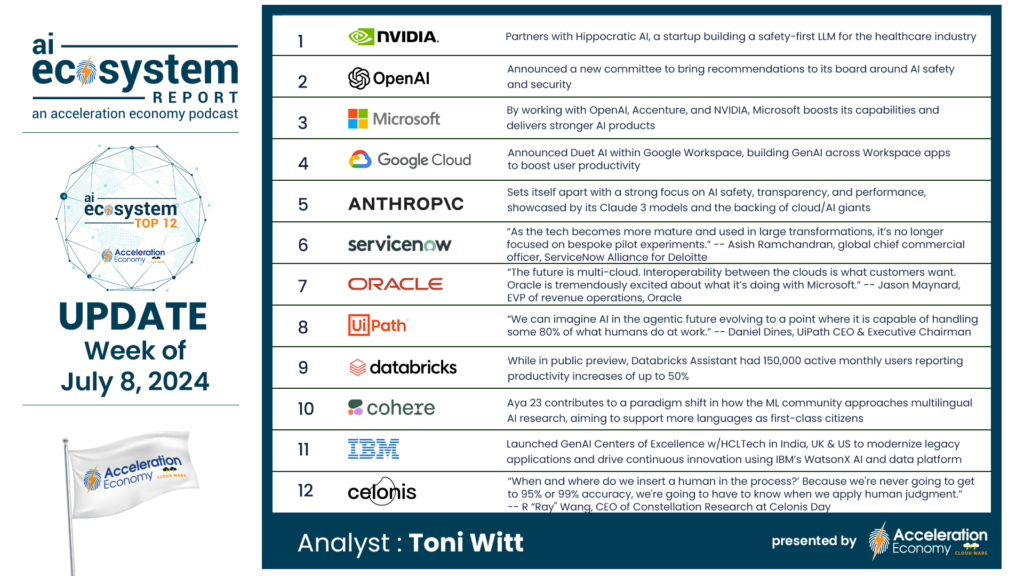
After boosting its growth rate from 13.2% in Q4 to 17.2% in Q1, AWS is riding several strategic growth vectors that should allow it to come very close to or perhaps even exceed that 17.2% growth rate when parent Amazon releases Q2 results at the end of July.
While I have in the past year moved Google Cloud and then Oracle above Amazon on the Cloud Wars Top 10 weekly rankings, I am bullish on the growth prospects for AWS, which in Q1 generated $25 billion in revenue and further established itself as one of the world’s pre-eminent technology companies.
My major concern about AWS over the past couple of years is that it has been spending too much time, if I may quote Jethro Tull, living in the past while Google Cloud and Oracle have both demonstrated more ambitious and more forward-looking visions for what the cloud+AI of the future will be.
But based on some remarks Andy Jassy made on Amazon’s Q1 earnings call a couple of months ago, I’d like to share six specific reasons to be bullish on the ability of Jassy and new AWS CEO Matt Garman to maintain that 17% growth for Q2 — and perhaps beyond.
1. Massive GenAI opportunity. “Our AWS customers are also quite excited about leveraging GenAI to change the customer experiences and businesses,” Jassy said on the call. “We see considerable momentum on the AI front where we’ve accumulated a multibillion-dollar revenue run rate already.”
Jassy expanded on that theme later in the call as he fused the GenAI phenomenon with AWS’s powerful existing position in the massive cloud market.
“And I think people sometimes forget that AWS is a $100 billion revenue run-rate business, and that we’re still seeing 85% of the global IT spend going to on-premises,” Jassy said. “And if you believe that equation is going to flip, which we do, it means we have a lot of growth in front of us, and that’s before the GenAI opportunity, which I don’t know if any of us have seen a possibility like this in technology in a really long time — for sure since the cloud, and perhaps even since the Internet.
“And unlike in the cloud, where there’s a lot of work to be done to move from on-premises to the cloud, people do it and they get value out of it, which is why they modernize their infrastructure. And it’s work. But all of this generative AI set of workloads, which will transform every experience, they’re going to be built from scratch on the cloud largely.
“And so they’re just tremendous opportunities” that are still in the early stages, Jassy said.
2. The “cloud optimization” slowdown has passed. “Companies have largely completed the lion’s share of their cost optimization and turned their attention to newer initiatives,” Jassy said.
“Before the pandemic, companies were marching to modernize their infrastructure, moving from on-premises infrastructure to the cloud to save money and innovate at a more rapid rate and drive more developer productivity. The pandemic and uncertain economy that followed distracted from that momentum, but it’s picking up again.
“And now companies are pursuing this relatively low-hanging fruit in modernizing their infrastructure.”

3. Customer demand for Amazon Bedrock is soaring. The AWS managed service that helps developers work with major foundation models to build GenAI apps has gained enormous momentum in the market. I dug into this in detail earlier this week in a piece headlined “AWS AI Surprise: ‘Tens of Thousands’ of Companies Building GenAI Apps on Amazon Bedrock.”
4. SageMaker generating strong customer demand. Jassy said customers are showing great interest in AWS’s SageMaker managed service. “Companies are also starting to talk about the eye-opening results they’re getting using SageMaker, our managed end-to-end service that’s been a game-changer for developers in preparing their data for AI, managing experiments, training models faster, lowering inference latency, and improving developer productivity. Perplexity AI trains models 40% faster…Workday reduces inference latency by 80% with SageMaker, and NatWest reduces its time to value for AI from 12 to 18 months to under seven months using SageMaker.”
5. Amazon Q: breakthrough assistant for developers? Jassy was particularly effusive about customer demand for Amazon Q, which he called “the most capable generative AI-powered assistant for software development and leveraging companies’ internal data. Q doesn’t just generate code — it also tests code, debugs coding conflicts, and transforms code from one form to another. Today, developers can save months using Q to move from older versions of Java to newer, more secure, and capable ones,” Jassy said.
6. Workday pairs up with hyperscalers, including AWS. This will certainly bring some new level of business to AWS, and is a broader indicator that the hyperscalers are now becoming strategic cloud-computing solution hubs pulling together a full set of capabilities rather than just AWS services. You can get the full story on that in my recent analysis headlined “Workday Goes Public Cloud with Google, AWS — Also Add Oracle, Microsoft?“

The AI Ecosystem Q1 2024 Report compiles the innovations, funding, and products highlighted in AI Ecosystem Reports from the first quarter of 2024. Download now for perspectives on the companies, investments, innovations, and solutions shaping the future of AI.








